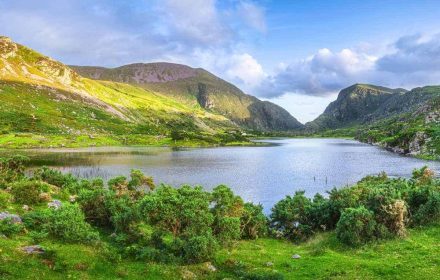This site uses affiliate links, meaning that if you make a purchase through our links, we may earn an affiliate commission.
Visiting Fontainebleau is an unforgettable experience, and it’s a place I believe everyone should explore at least once. This magnificent French château offers a glimpse into centuries of royal history and artistic splendor.
Unlike the bustling crowds of Versailles, Fontainebleau provides a more tranquil yet equally stunning escape, perfect for anyone passionate about history, art, or architecture.
Here’s everything you need to know about how to visit Fontainebleau and make the most of your time, from practical tips to the must-see highlights.
- 1. Where Is Fontainebleau, and How to Get There
- 2. Practical Information
- 3. Fontainebleau Timeline Highlights
- 4. 13 Best Things You Can't Miss
-
- 4.1. Horseshoe Staircase
- 4.2. François I Gallery
- 4.3. Napoleon's Apartment
- 4.4. Napoleon's Throne Room
- 4.5. Diana Gallery
- 4.6. Chapel of the Trinity
- 4.7. Empress' Bedchamber
- 4.8. Queen's Silver Boudoir
- 4.9. Pope's Apartment
- 4.10. Park at Fontainebleau
- 4.11. Grand Parterre
- 4.12. Diana Garden
- 4.13. English Garden
Where Is Fontainebleau, and How to Get There
Fontainebleau is about 55 kilometers (34 miles) southeast of Paris, making it an easy day trip. Here are your options:
- By Train: Take a direct train from Gare de Lyon in Paris to Fontainebleau-Avon station (about 40 minutes). From there, hop on Bus 1, which stops directly in front of the château, or grab a taxi for a quick 10-minute ride. Trains are frequent, and this is a stress-free and scenic way to travel.
- By Car: I rented a car for my trip, which gave me the flexibility to explore more than just the château, like the nearby town of Barbizon and parts of the Forest of Fontainebleau. The drive is straightforward, taking about an hour via the A6 highway.
GOOD TO KNOW: Note that the A6 is a toll road, so be prepared to pay a small fee (around €2-€4 depending on your entry and exit points). Parking is plentiful near the château, with lots conveniently located within walking distance.
PRO TIP: Download a GPS app with offline maps to avoid getting lost, especially if you want to venture into the forest or surrounding areas.
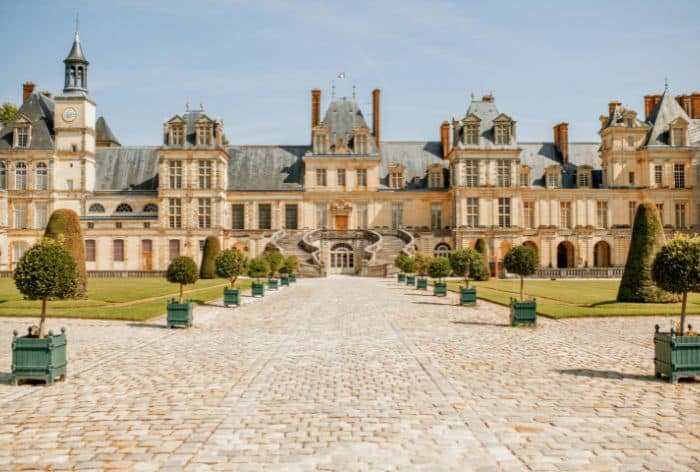
Château Fontainebleau / How to Visit Fontainebleau
- By Organized Tour: Many travel agencies in Paris offer guided day trips to Fontainebleau, which include transportation. While pricier, this option takes the planning out of your hands and often includes historical insights from a guide
PRO TIP: The first time I visited Fontainebleau, I wasn’t comfortable driving or familiar with the train system, so I opted for an organized tour. I joined the Fontainebleau and Vaux le Vicomte Chateaux Day Trip from Paris, and it was very good! It wasn’t expensive and included transport, tickets to both châteaux and plenty of free time to explore.
- By Bus: Regional buses connect Fontainebleau with neighboring towns, but the train is usually faster and more convenient when traveling from Paris.
Practical Information
Here’s what you need to know to plan your visit:
- Opening Hours: The château is open daily except Tuesdays, January 1, May 1, and December 25. From October to March, it’s open from 9:30 AM to 5:00 PM (last entry at 4:15 PM). From April to September, it’s open from 9:30 AM to 6:00 PM (last entry at 5:15 PM).
- Entry Fees: Admission costs €12 for adults. Reduced rates are available for children, students, and groups. EU residents under 26 can enjoy free entry, and everyone can visit for free on the first Sunday of each month (November to March). Make sure to bring a valid ID for reduced or free entry eligibility.

Château Fontainebleau / How to Visit Fontainebleau
- Accessibility: Most areas of the château are wheelchair-accessible, and free audioguides in multiple languages enhance your visit.
- Food and Facilities: The on-site café serves snacks and meals, and the gardens provide a perfect picnic spot.
- Tickets: Purchase tickets online in advance to avoid lines during peak seasons.
GOOD TO KNOW: You can purchase your tickets HERE.
PRO TIP: From my personal experience, you’ll need about 4-5 hours to explore the Château de Fontainebleau and its gardens fully. This gives you enough time to enjoy the interior, the gardens, and the surrounding parkland without feeling rushed.
Fontainebleau Timeline Highlights
The Château de Fontainebleau boasts a history that stretches back over 800 years, making it one of France’s most storied royal residences.
Here are some fascinating highlights to inspire your visit:
- 12th Century: Fontainebleau began as a modest hunting lodge commissioned by Louis VII. Its location was prized for the dense surrounding forest, rich with game.
- 16th Century: King François I transformed the lodge into a grand Italian-inspired palace, introducing Renaissance art and architecture to France. He brought in artists like Rosso Fiorentino and Primaticcio, who established the “School of Fontainebleau,” celebrated for its unique style blending French and Italian influences. François I also added his emblematic salamanders, which can still be spotted throughout the palace.
GOOD TO KNOW: François I was so enamored with Italian culture that he invited Leonardo da Vinci to France, where the artist brought the Mona Lisa and other masterpieces. Fontainebleau housed some of these treasures for a time.

Château Fontainebleau / How to Visit Fontainebleau
- 17th Century: Under Louis XIV, the Sun King, Fontainebleau saw significant expansions. He commissioned the magnificent Horseshoe Staircase and frequently used the château for hunting retreats and political gatherings. The opulence of Versailles may have overshadowed Fontainebleau, but it remained a vital royal residence.
- 18th Century: During the reign of Louis XVI and Marie Antoinette, Fontainebleau became a serene escape from the intense pressures of Versailles. Marie-Antoinette’s Turkish Boudoir, with its exquisite décor, showcases her refined taste.

Château Fontainebleau / How to Visit Fontainebleau
- 19th Century: Napoleon Bonaparte adored Fontainebleau, calling it “the true home of kings.” He redecorated the palace and made it the stage for key historical events, such as the signing of his abdication in 1814. Standing on the Horseshoe Staircase, he bid an emotional farewell to his troops before his exile.
GOOD TO KNOW: The throne room at Fontainebleau is the only surviving throne of an emperor in France. Napoleon’s apartments at Fontainebleau are some of the most intact of his residences, offering a glimpse into his personal life and tastes.
- 20th Century: Recognized for its cultural and historical significance, Fontainebleau was designated a UNESCO World Heritage Site in 1981. Its preservation allows visitors to experience centuries of royal history firsthand.
13 Best Things You Can't Miss
Horseshoe Staircase
Built between 1632 and 1634 under Louis XIII, the Horseshoe Staircase is a masterpiece of architect Jean Androuet du Cerceau.
Its unique design provides access to the François I Gallery and the château’s Grand Apartments.
More than just a practical feature, this staircase set a new standard in architectural beauty and inspired similar designs across Europe.

View from the Horseshoe Staircase / How to Visit Fontainebleau
It’s also steeped in history. From the 17th century onward, the staircase served as the backdrop for welcoming princesses destined to marry into the French royal family. Notably, it was used for grand ceremonies like the arrivals of the Duchess of Burgundy in 1697 and Marie Leszczynska in 1725.
But its most famous moment came in 1814 when Napoleon stood here to deliver his poignant farewell to the Imperial Guard before his exile to Elba.
PRO TIP: For the best photos, try different angles of the staircase and capture the curves of the staircase with the palace as a dramatic backdrop.

The Horseshoe Staircase / How to Visit Fontainebleau
François I Gallery
The François I Gallery is one of the most iconic spots in the Château de Fontainebleau. Located on the first floor, it connects the keep with the church of the Trinitarian convent, and it’s a stunning example of Renaissance style.
When it was created in the 1530s, it was the first of its kind in France—a huge, elegant space packed with ornate wood paneling, stucco designs, and frescoes.
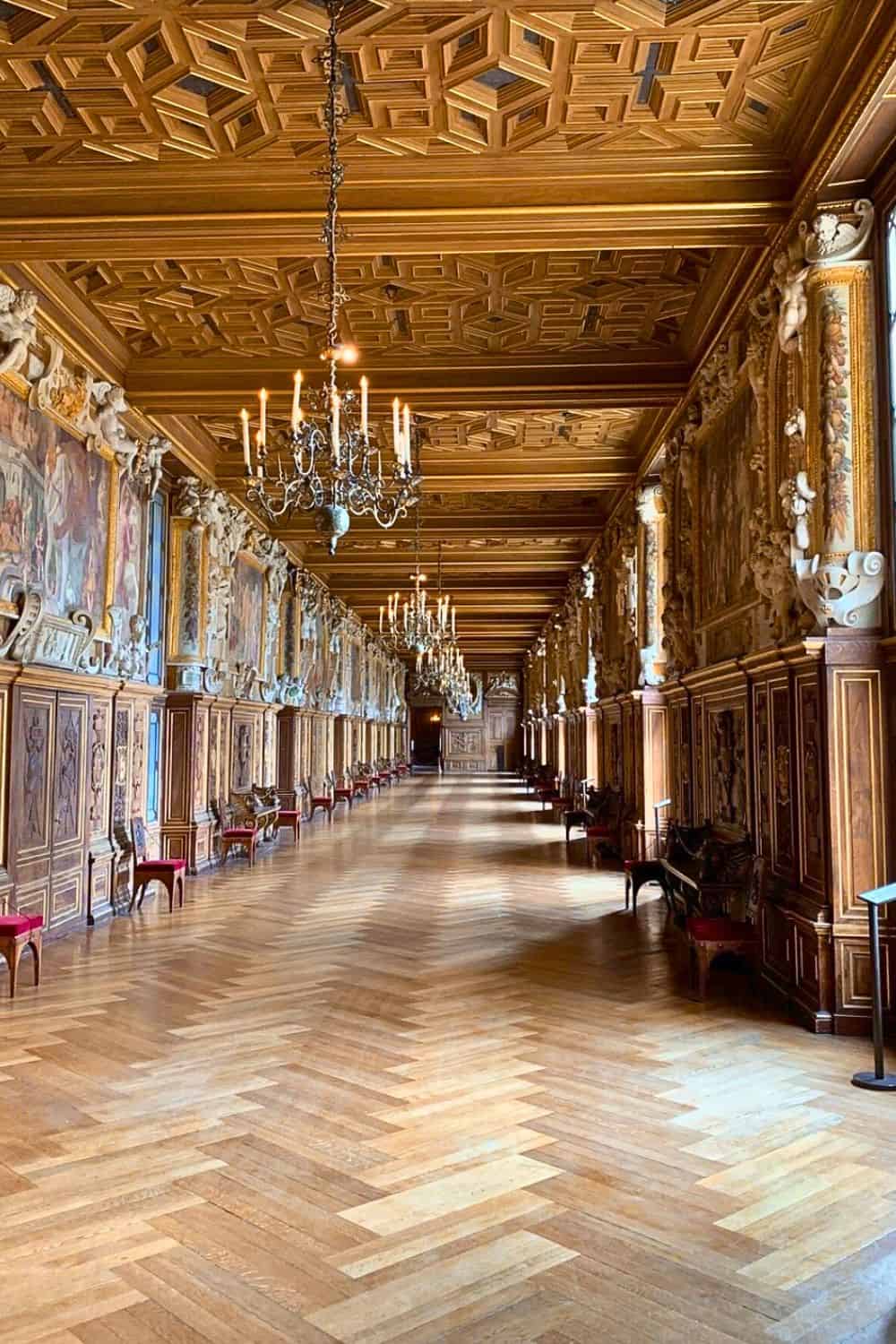
François I Gallery / How to Visit Fontainebleau
The Florentine painter Rosso Fiorentino designed the gallery’s decor, using intricate details like putti (little angels), fruits, and rolled leather motifs. The whole room feels like an art gallery, with each section of the wall telling a story through allegory and references to mythology and ancient history.
GOOD TO KNOW: The gallery was originally a private space, with King François I keeping the key around his neck. It was connected directly to his bedroom, and only later in the 16th century did it become a public space.
Napoleon's Apartment
Napoleon’s apartment at Fontainebleau offers a glimpse into the emperor’s life during his final years in power.
In my opinion, the most fascinating are the Abdication Room and Napoleon’s Bedroom.
The Abdication Room is where one of the most dramatic moments in French history unfolded. The room is richly decorated with white woodwork trimmed in gold, crimson brocade, and ornate furniture.
It was in this room, at a small pedestal table, that Napoleon was forced to sign his abdication in April 1814, marking the end of his reign under pressure from his marshals.
Napoleon’s bedroom is the most important part of his apartment, originally a powder room used by Louis XVI. The room was refurnished in 1808 and features a grand bed with gilded columns, decorated with symbols of Nobility and Glory.
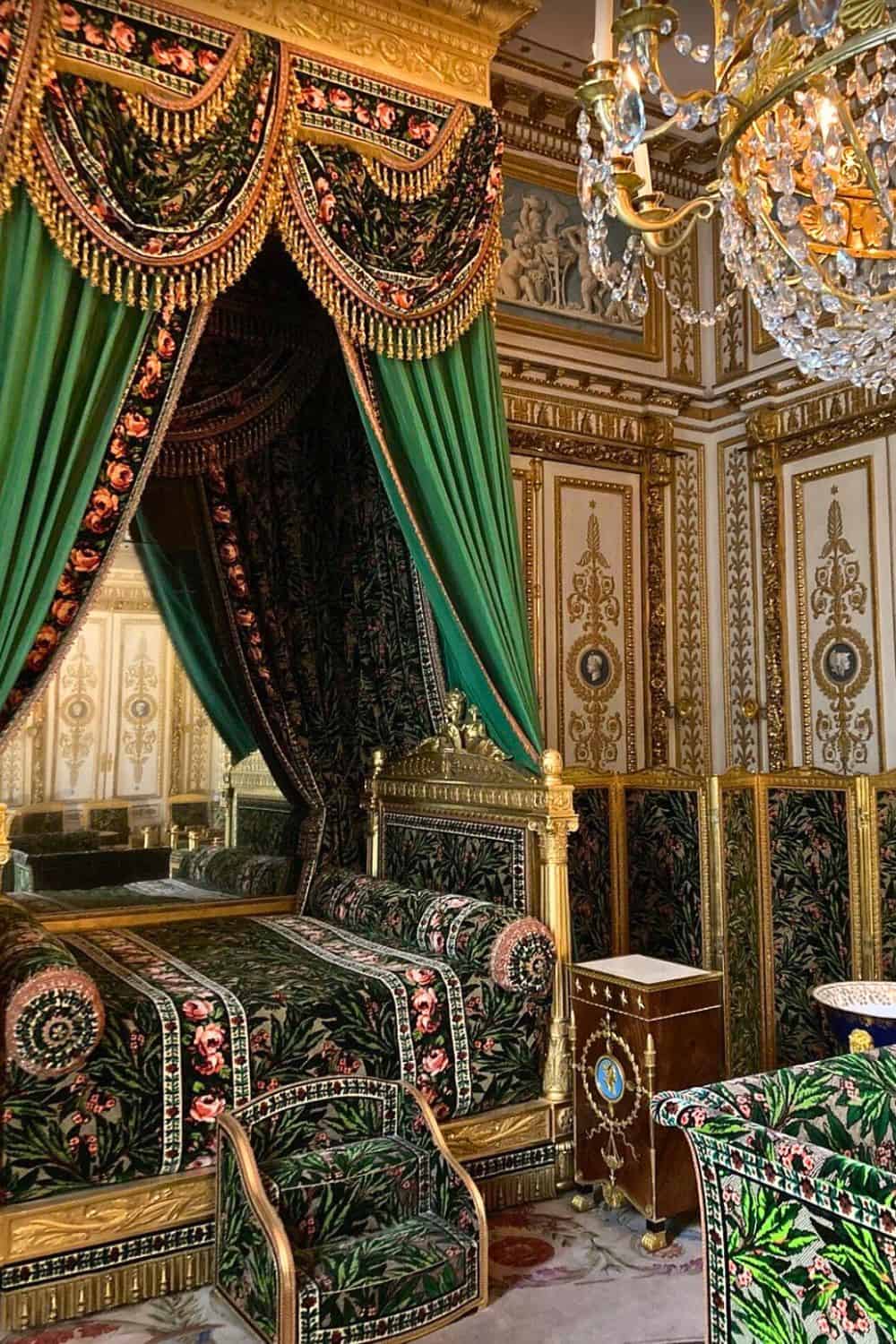
Napoleon’s Bedroom / How to Visit Fontainebleau
This was also the place where, after his abdication in 1814, Napoleon tried to poison himself. He survived the attempt, and upon realizing he was still alive, he famously said, “God does not want it!”
Napoleon's Throne Room
The Throne Room at Château de Fontainebleau holds a special place in French history. Originally the King’s bedchamber, it was transformed by Napoleon I in 1808 after the Revolution, and it served as a throne room until the Second Empire.
The room still retains much of its royal heritage, including the panelling, a marble fireplace adorned with gilt bronze, and carved gilded medallions bearing the motto of Louis XIII.
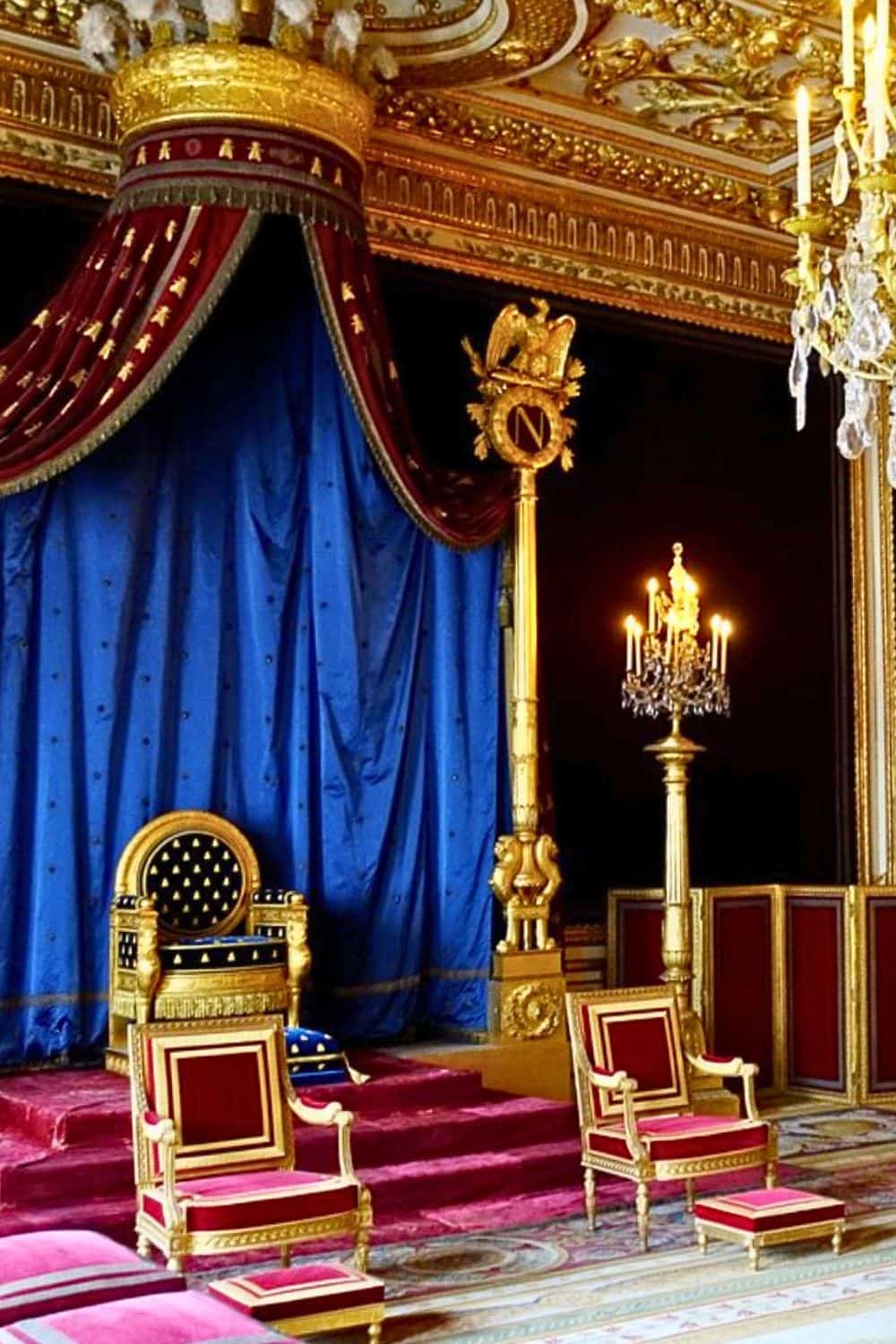
Throne Room / How to Visit Fontainebleau
During the Revolution, the original bed and furniture were removed, leaving behind a space that had once been the heart of court rituals, including the monarch’s public ceremonies of rising and retiring.
Napoleon replaced the bed with an imposing throne in the alcove, setting it on a purple dais adorned with golden bees—a symbol of his empire.
The room’s decor is rich with Napoleonic symbols, such as eagles, laurel crowns, and his imperial cipher, all reflecting his desire to assert his power through heraldic imagery.

Throne Room / How to Visit Fontainebleau
Diana Gallery
The Diana Gallery is the longest room in Château de Fontainebleau, stretching a massive 80 meters. It was originally called the “Queen’s Gallery” because it was part of the sovereign’s apartment.
Built during Henry IV’s time, the gallery was decorated with murals by Ambroise Dubois and Jean Dhoey around 1605, featuring the goddess Diana.

Diana Gallery / How to Visit Fontainebleau
But by the time Napoleon I came along, the gallery was in poor shape, and he oversaw a big renovation in 1810. The space was eventually completed in 1826, with new paintings by Abel de Pujol and Merry Joseph Blondel taking the place of the old ones.
In the 19th century, Napoleon III made the gallery even more special by turning it into a library, filling it with 16,000 books from Napoleon I’s collection. He also added a globe from the Tuileries Palace.
Chapel of the Trinity
The Chapel of the Trinity at Château de Fontainebleau was initially part of the Trinitaires Convent and rebuilt during François I’s reign.
It was further developed in the early 17th century under Henri IV, who commissioned the creation of its iconic vault after a suggestion from the Spanish ambassador. The vault, painted by Martin Fréminet, is framed by elaborate stucco moldings and features a design that predates the Baroque style.

The Chapel of the Trinity / How to Visit Fontainebleau
The chapel was completed in 1633 under Louis XIII and has been the site of significant events, such as the marriage of Louis XV in 1725 and the baptism of Napoleon III in 1810.
Empress' Bedchamber
The Empress’ Bedchamber, originally used as the Queen’s Bedchamber, has been the bedroom for many of France’s queens, from Marie de Medici to Marie Antoinette.
The large bed in the room is a piece from Marie-Antoinette’s time, featuring a headboard decorated with cupids, quivers, and a medallion with her initials. The bed sits on a raised dais, with a cupid surrounded by flowers.
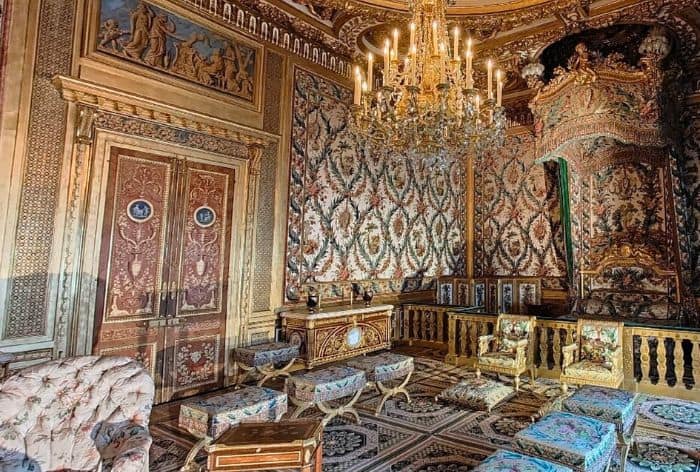
Empress’ Bedchamber / How to Visit Fontainebleau
This room was designed as a ceremonial space, where the queen’s private area was separated from the public space of courtiers by a gilded wooden balustrade.
Though the bed was delivered to Marie-Antoinette in 1787, she never had the chance to sleep in it.
After the Revolution, Empress Josephine took over the room and decorated it with soft silk fabrics and floral designs. These decorations, including flowers, musical instruments, and symbols of fertility, were meant to emphasize the queen’s role in producing heirs for the throne, celebrating her motherhood and the future of the royal family.
Queen's Silver Boudoir
The Queen’s Silver Boudoir was Marie Antoinette’s personal retreat, a place where she could escape from the strict court rituals.
The room’s design is elegant, with silver and gold paneling that gives it a sophisticated, feminine feel. Gilded doors are topped with delicate plaster sculptures of the Muses, while the ceiling features a painted sky with Aurora and her cupids, creating a serene atmosphere.

Queen’s Silver Boudoir / How to Visit Fontainebleau
In the 19th century, Empress Eugenie added a bathtub to the boudoir, making it her private space for relaxation. Eugenie, a great admirer of Marie Antoinette, felt isolated in the court, often describing it as a place where she was surrounded by people but never alone.
The Silver Boudoir provided her a much-needed escape from the pressures of royal life.
Pope's Apartment
The Pope’s Apartment is one of the most lavish spaces at Fontainebleau. It was originally created in 1804 by combining two separate apartments into one grand space, designed to host important guests.
The apartment is named after Pope Pius VII, who stayed there both as a guest in 1804 and as a prisoner during 1812-1814 under Napoleon.

Pope’s Apartment at Fontainebleau / How to Visit Fontainebleau

Pope’s Apartment at Fontainebleau / How to Visit Fontainebleau
The apartment’s original section dates back to the 16th century and was used by royal figures like Anne of Austria, the Queen Mother.
In the 1860s, Napoleon III and Eugenie renovated the space, preserving its historic ceilings while adding their own touch.
Park at Fontainebleau
The park at Fontainebleau is an enormous and peaceful retreat that extends far beyond the Bassin des Cascades, marking what used to be the edge of the royal grounds.
Back in the day, it was the main route leading visitors from the nearby village of Avon to the château.
Its current layout, complete with flowing cascades and tree-lined pathways, dates back to the early 1600s when Henry IV designed the impressive canal. This waterway is massive—1,200 meters long and 40 meters wide—and was considered a huge engineering achievement at the time.

Park at Fontainebleau / How to Visit Fontainebleau
Henry IV was hands-on with the park’s transformation, personally overseeing the planting of over 60,000 trees, including silver poplars, oaks, and fruit trees, to create a lush, enclosed green space.
In 1609, it took over a week to fill the canal with water, and the king even sailed on it later that fall, showing off his new pride and joy.

Park at Fontainebleau / How to Visit Fontainebleau
Grand Parterre
The Grand Parterre is a highlight of the Fontainebleau gardens and the largest formal garden of its kind in Europe, spanning 14 hectares.
It was designed between 1660 and 1664 by André Le Nôtre and Louis Le Vau for Louis XIV, showcasing the king’s love of grandeur and open landscapes.
The garden is home to notable features, including the Bassin des Cascades, facing Henry IV’s Canal. A bubbling square pool, called the “pot bouillant,” was added to its center in 1817, along with a statue of the Tiber River near the forest edge.
Diana Garden
The Diana Garden is a charming space at Fontainebleau, originally created as a private retreat for the Queen.
Bordered by the Empress’ private apartments and Marie Antoinette’s Turkish boudoir, it offers a glimpse into the more personal side of royal life.
Today, the garden is designed in the picturesque style of an English landscape garden, featuring impressive trees like a Catalpa and an American tulip tree.
At its heart is a circular pond crowned by the Diana the Huntress fountain, a stunning piece commissioned by Henry IV. The fountain’s pedestal is adorned with bronze stag heads and hunting dogs, symbolizing Fontainebleau’s historic role as a royal hunting estate often referred to as the “Temple of Diana.”

Park at Fontainebleau / How to Visit Fontainebleau
English Garden
The English Garden was designed between 1810 and 1812 by the architect Hurtault, who also created the grand iron gates of the Grille d’Honneur.
Even though Napoleon wasn’t a huge fan of this style, English gardens were all the rage at the time. The garden’s charm lies in its winding paths, rare trees from all over the world, and the tranquil artificial river that winds through it.
Hidden among the garden’s twists and turns is the Fontaine Belle-Eau, the spring that gave Fontainebleau its name.

Park at Fontainebleau / How to Visit Fontainebleau
Here Are Some More Ideas of Places to Visit in France:
Did You Find How to Visit Fontainebleau Useful?
Why Not Save It to Your Pinterest Board!


Now, It Is Your Turn, I Would Like to Hear Back from You!
Are you planning your trip to France?
Please let me know!
Drop me a quick comment right below!
Click on any of the images below to get inspired!
